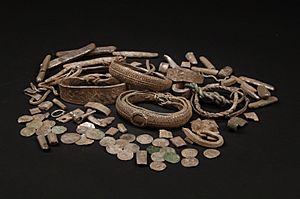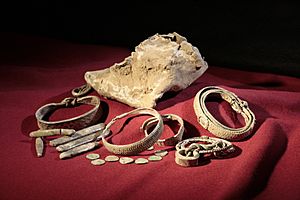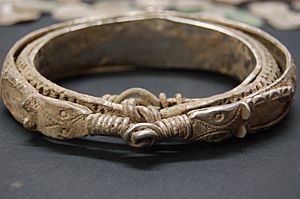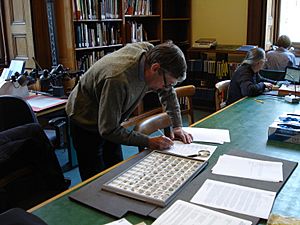Silverdale Hoard facts for kids
The Silverdale Hoard is a special collection of over 200 silver items. These include beautiful jewelry and old coins. It was found near Silverdale, Lancashire, England, in September 2011.
The items were buried together in a lead container, about 16 inches (40 cm) deep. A metal detectorist found it in a field. Experts believe the hoard dates back to around AD 900. This was a time when the Anglo-Saxons and Danish settlers in northern England often fought.
This hoard is one of the biggest Viking treasures ever found in the UK. The Lancashire Museums Service bought it. You can see parts of it at Lancaster City Museum and the Museum of Lancashire in Preston. It's very important because it has a coin with the name of a Viking ruler nobody knew about before!
Contents
How the Hoard Was Found
A local metal detectorist named Darren Webster found the hoard. He had been searching the field for only 20 minutes. He had looked in that same field many times before but found nothing exciting. His wife had given him the metal detector for Christmas. He was trying his luck before going to work.
When he first found the lead container, he was a bit disappointed. It looked like just a flat piece of lead. But when he lifted it, he saw it was shaped like a box. Silver objects spilled out as he picked it up! Darren knew right away that it was something special. He quickly realized it was "more than likely Viking." He reported his amazing find to the local Finds Liaison Officer. The items were then taken to the British Museum to be weighed, studied, and cleaned.
What Was Found in the Hoard
The Silverdale Hoard has many different silver items. There are 27 coins, 10 arm-rings, and 2 finger-rings. It also includes 14 silver bars called ingots. There are 6 pieces of brooches and a fine silver wire braid.
A large part of the hoard is 141 pieces of chopped-up arm-rings and ingots. These small pieces are called hacksilver. Vikings used hacksilver as a form of money. All the items together weigh a little over two pounds (1 kg).
The coins in the hoard come from different places. Some are Arabic, some are Anglo-Saxon, and some are Anglo-Viking or Viking. They all date to around AD 900. Some coins are from Alfred the Great. Others are from the Danish-ruled Kingdom of Northumbria.
Some of the silver items were probably worn as jewelry. They might have shown how important the owner was. Leaders would give arm-bands to warriors as a reward. One arm-band is very special. It has designs from Irish, Anglo-Saxon, and Carolingian styles all mixed together.
The Mystery Coin
One coin in the hoard is very exciting because its design was unknown before. It has the name AIRDECONUT on it. This name seems to be a version of the Scandinavian name Harthacnut. The other side of the coin has the letters DNS (Dominus, meaning Lord) and REX (King) in the shape of a cross. This shows the ruler was Christian.
This coin's design is similar to coins made by Viking rulers Sigfroðr and Knútr. They might have ruled Northumbria together between 895 and 905. The name Airdeconut has never been seen before. It seems to belong to a Viking ruler we didn't know existed! This person is believed to be the first new medieval ruler found in England in 50 years. He is also the first "new" Viking king identified since 1840.
Another Important Coin
Another important coin is a silver penny from about 900–902. It says ALVVALDVS (Alwaldus) on it. This is thought to refer to Æthelwold. He was the son of Alfred the Great's older brother, King Æthelred I. After Alfred died in 899, Æthelwold tried to become king. He then ran away to Northumbria, where he was accepted as a king. Æthelwold was killed in the Battle of the Holme in 902.
The Silverdale Hoard is the largest Viking treasure found in the UK since the Vale of York Hoard in 2007. It's the fourth-largest Viking hoard ever found in the UK. It is very similar to the much bigger Cuerdale Hoard. That hoard was found in 1840, about 40 miles (64 km) away. Both hoards were probably buried around AD 900. This was a time of fighting between Viking settlers and the Anglo-Saxons. Anglo-Saxon kings like Alfred the Great and Edward the Elder wanted to take back control of areas ruled by the Danes.
The hoard would have been worth a lot of money back then. Maybe as much as a large group of sheep or cattle. The fact that the owner never came back for it suggests they might not have survived the conflicts.
Where the Hoard Has Been Displayed
The British Museum showed some of the finds from mid-December 2011 to the New Year. On December 16, 2011, a Lancashire coroner officially declared the hoard to be "treasure." An independent committee then figured out how much the hoard was worth. The money was shared between the person who found it and the landowner.
The hoard was valued at £110,000. In October 2013, it was announced that the Lancashire County Museum Service had bought the hoard. They got help from grants of £45,000 from the National Heritage Memorial Fund and £33,000 from the National Art Fund.
The hoard was then part of a special display. It was called "The Silverdale Hoard: the Story So Far." It was shown at Lancaster City Museum from October 25 to December 21, 2013. Many people came to see it, setting new visitor records for the museum. After that, it moved to the Museum of Lancashire in Preston. It was displayed there from February 15 to December 7, 2014.
The Museum of Lancashire closed to the public in 2016. However, the hoard was displayed again in the Harris Museum, Preston, from June to August 2019. This was part of an exhibition called "Fearsome Craftsmen," which showed Viking crafts. In February 2020, there were plans to try and get money to display the hoard temporarily in Silverdale village library.
Images for kids








